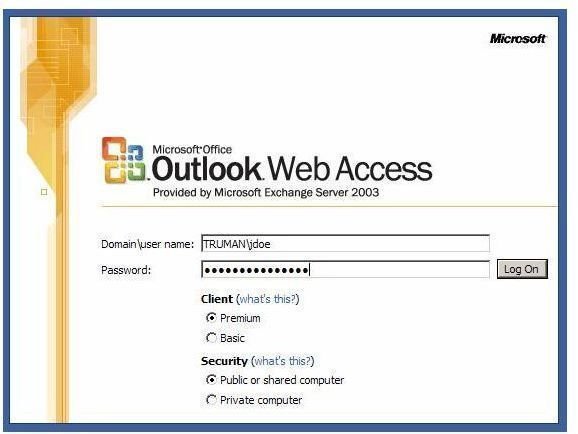Fixing Frequent Outlook Web Access Authentication Requests
Authentication? What Does That Mean?
When you first buy a program from a developer, chances are that you’ll need to prove that you truly have an account for it. This lets the publishers know that you didn’t just go online, download an illegal copy, and then crack it until it was functional. Ultimately. it gives them a better idea of how much money they can make vs. how much money they should be making, and keeps their customers honest. Because of this, they implement something called “authentication”, which has you put in a special username and password that is only for you. The only way to get one of these usernames/passwords? Legally buy the product.
This, in essence is a great feature that ensures people won’t steal from hardworking technology companies, but sometimes - like in the case of Outlook Web Access - something goes wrong and the program continuously asks for authentication every time you need to log in, rather than just one time you’re accessing it. This is frustrating to say the least, but when you have to take an extra ten seconds to type something every day, and you do that several times a day for many months, the spare time can really add up quickly. This is exactly why, in this article, we will explain just how to stop this problem from persisting, and do our best to help you prevent it from ever happening again.
Reset Your Password
The first thing you can do that has been shown to help with this problem is resetting your OWA log in password, which is a pretty straightforward and simple procedure, so if you already know how to do is, then fantastic, go do it right now and check to see if it was successful. If not, here’s a quick guide:
- Open up the “Users and Computers” Settings
- Expand the Users OU box, and locate the user name for which you want to reset the password
- Right click on that particular username and choose “Reset Password”. Remember not to leave the password field blank when you do this, because doing so will cause the operation to fail.
After you do this, try logging in again (close the program first and then reopen it) to see if it made any difference. If it didn’t, another thing you can try is going into the user’s settings and making sure that “Password never expires” and “User cannot change password” are selected. If they are, things should run smoothly for you.
Check Your Browser’s Settings

A lot of the time people assume that problems are caused by one program, when really it’s the product of a parent application not being configured properly, and in this case it could be that your web browser - whether you use Firefox, Internet Explorer, or otherwise - isn’t set up to recognize the OWA site as a trusted and secure network. If you suspect this might be the case, here’s what you need to do:
Firstly, go into the preferences/options for whatever app you’re using, then head on over to the “security” tab. In this, you should see a few different things, one of which will be “Security Exceptions” or “Firewall Settings”. Go into one or both of these directories and add the OWA URL that you most commonly access to the list of accepted websites. This will tell your computer that such places can be totally trusted, and they should allow you to do an automatic log in from now on.
Allowing Authentication Within OWA
If you’ve added the OWA websites to your local intranet zone and you’re still not having any luck gettings things done, there is one more thing that I would recommend trying. Head back into the OWA settings for your personal account and make sure the following two boxes are checked:
- The anonymous authentication is enabled on Default Web Site
- The windows authentication is enabled on OWA virtual directory
If both of those boxes are selected (and they should be by default) already, then you’re pretty much out of luck. If, however, they are not selected, this could very well be the one thing that ultimately fixes your issue. Select them, restart OWA, and hopefully things will go completely smoothly.
If, after trying all three of these solutions nothing is working, please leave a comment on this article and we will do our absolute best to research the issue further and find an answer that suits your needs. Thankfully, fixing frequent Outlook Web Access authentication isn’t a tough project compared to most computer issues, so until then, I hope everything worked out, and happy OWAing!
References
- [Information] Author Knowledge
- [Information] General Troubleshooting Information, http://social.technet.microsoft.com/Forums/en/exchangesvrgeneral/thread/e128991c-61a0-47f1-80c7-cef17d7acb7d
- [Image] Official Internet Explorer Logo
- [Image] Outlook Web Access Login Page, http://its.truman.edu/Image/outlook_web_access/outlookLogon.jpg
- [Information] More General Troubleshooting Information, http://www.outlookforums.com/showthread.php?16621-OWA-keeps-asking-for-authentication
